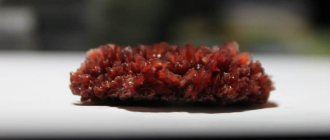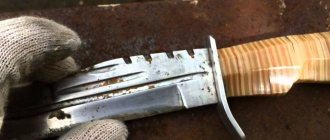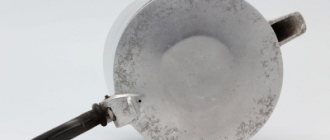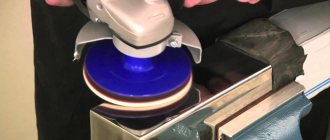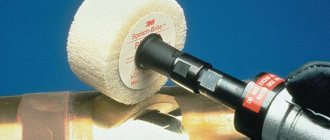What is electropolishing?
This is an electrochemical polishing of metal, which allows you to smooth and clean the surface of the product, thereby improving its functionality and appearance. It is based on the principle of electrolysis. The electrolysis process uses current, a solution of sulfuric acid (for the most part) and phosphoric acid as an electrolyte. Electropolishing can be used on a variety of metals, especially stainless steel. Unlike galvanized cleaning, polishing does not damage the top layer of the product. The processing is carried out at a microscopic level and polishes the surface within 20-30 micrometers.
What you need to polish aluminum at home
To carry out the process of grinding and cleaning aluminum products yourself, you need to purchase a special paste for polishing aluminum.
It is relatively safe if you follow the recommendations for using the polishing compound. For polishing you may also need:
- medium or fine abrasive sandpaper;
- brushes with metal bristles;
- varnish;
- alcohol-containing liquid;
- rags.
Varnish is necessary for the final coating of the part. It will increase wear resistance and protect aluminum from further damage.
Which polish to choose
Aluminum polish copes well with various defects and corrosion on the surface of products. The polish has a paste-like consistency, making it convenient to use at home. Aluminum polishing pastes have several undeniable advantages:
- Pastes do not contain ammonia, their composition is not as aggressive and dangerous as that of acid solutions used in industrial metal polishing.
- Effectively affects scratches and other defects on the surface of aluminum, returning parts to their original appearance and shine.
- After using a special paste, a protective layer is formed on the surface of the parts, which prevents oxidation over a long period.
There are many different brands of polishes. You should choose based on the nature of the work performed, the types of parts and the price category of the paste itself.
The easiest way to polish aluminum yourself
VIEW Paste for polishing aluminum
It is quite easy to polish aluminum at home using a special paste:
- Using a stiff metal brush, it is necessary to rid the surface of the part of paint residues and dirt.
- It is necessary to process the part with medium abrasive sandpaper, rubbing out all large defects and irregularities.
- Using fine abrasive sandpaper, the part is polished until its surface becomes as smooth as possible. You can skip this step and immediately use a special polish.
- A small amount of paste should be applied to the aluminum and using a rag (it is advisable to use fabrics with a natural composition: cotton or wool) rub the part with paint in a circular motion. After achieving the desired effect, the remaining paste is removed with a clean cloth.
If, after treating the aluminum surface with polish, visible defects remain, the procedure is repeated.
- If desired, the polished part can be varnished, which will increase the wear resistance of the part.
If you have had experience in polishing aluminum products in industrial or home conditions, you can share your experience in the comments.
Why is electropolishing needed?
As a result of electropolishing, the metal coating becomes perfectly smooth, clean and sparkling like new.
Unlike mechanical cleaning, polishing does not damage the top layer of the product. The product gets rid of irregularities and elements of rust, allowing you to increase the operating time and quality of work with it. It applies to the following products:
- Auto parts
- Construction tools and their components
- Metal pipes, springs and tanks
- Decorative elements and dishes
- Pharmaceutical equipment
Traditional methods of cleaning and polishing aluminum products
To give a shiny look to household items and decorative elements, use various recipes with simple and inexpensive ingredients.
Sour apple
To clean the container from carbon deposits, you need to cut the apple in half and rub the surface well with the half. The acid in the fruit helps to quickly remove soot.
Kefir or cucumber pickle
To combat dark spots, leave the dishes with brine or kefir inside for 12 hours. Next, you need to wash the product in warm water with a soft cloth.
Baking soda
Dilute soda with water to a paste consistency, which is applied to the metal and wiped with a sponge. This method will help to clean the product from plaque and dirt, and polish it to a shine.
Baking Soda - Aluminum Polish
Ammonia and borax
A homemade polishing mixture of borax (15 g) and ammonia (5 g) allows you to restore the beauty of the product and give the thing a mirror-like shine. The composition is applied with a sponge and rubbed well, then rinsed under running water.
Electroplating
Metal products are often exposed to various harmful influences, losing their original appearance and technical characteristics. That is why galvanic coating is a relevant service. The processes are performed in approximately the following sequence:
- preparatory work - removing dirt, grease and mechanical processing products from surfaces
- machining – removing signs of wear by grinding and polishing (if necessary);
- washing with an organic solvent – to remove dirt and oil;
- degreasing;
- etching;
- coating;
- washing with water and alkaline solutions.
When applying various types of coatings, it is necessary to understand that there are various approaches and technological methods, the use of which allows you to obtain the required result and which should be taken into account in order to obtain high-quality and durable processing results with improved characteristics of the parts.
Preparatory processes should be carefully carried out, since the ease and efficiency of galvanization, as well as the service life of the surface, depend on them. For this reason, it is better to order work from specialized enterprises.
Classification of galvanic coatings.
For many years, galvanization has been a popular method for processing various metal products: equipment parts, jewelry and much more. To carry it out, special equipment is required that will allow for high-quality electroplating . In addition, it is better to entrust processes to competent specialists with experience in this activity - many enterprises cooperate with on an ongoing basis.
Source
Electrochemical polishing of steel
Aluminum is a fairly light and durable metal, and therefore is often used in the kitchen as the main material from which cookware is made. When plaque appears, it becomes unpleasant to cook in it, and it is impossible for safety reasons, and therefore the question arises of how to clean aluminum until it shines.
Cleaning features, general recommendations
Heating of aluminum cookware occurs evenly and does not require much time. After some time, carbon deposits begin to appear on aluminum cookware and traces of oxide become noticeable. Most often, they try to clean aluminum using dishwashing detergent, but it can only remove external dirt and grease.
Dishes made from this material should only be washed cold, since they can easily be damaged when hot. If a hot metal is immersed in cold water, it will become deformed, and therefore you should try to avoid such a failure.
You should not try to clean burnt food immediately using iron sponges and other objects. To make the task easier, you just need to pour warm water and wait about half an hour. During this time, the food will get wet and can be removed using a regular dishwashing sponge.
It is not recommended to wash aluminum cookware in the dishwasher, since the dishwasher uses hot water during the washing process, which can damage the material. To avoid deformation, it is recommended to wash aluminum cookware by hand with warm water.
You should not use strong acids in the process, as they will not be able to restore the shine of the dishes, and may harm them. It is also not recommended to clean it with metal sponges, which leave scratches on the dishes.
Chemical polishing
Fast, simple, economical - this is how you can characterize this method of polishing small aluminum parts.
A solution of acids (orthophosphoric, sulfuric, nitric) with special additives is poured into a polishing bath made of acid-resistant steel (if the volumes are small - porcelain crucibles).
The parts are immersed in a hot solution (the solution temperature is high - 90-120°C - depending on the type of aluminum) for half a minute to a minute 5-6 times. In the intervals between dives, the parts are washed in a catcher, constantly shaking them.
Better polishing is obtained in a drum rotating at a certain speed. Parts with complex profiles are polished in a solution with a greater degree of preliminary use.
After chemical polishing, a film of contact copper remains on the product. To remove it, the products are washed under low-temperature running water in a trap and treated with 30% nitric acid.
Also, when chemically polishing aluminum, alkali solutions are used (trisodium phosphate, caustic soda, sodium nitrate, sodium nitrate). Alkaline solutions should have a higher temperature than acid solutions and may be 120-140°C. Exposure in solutions ranges from 5 to 20 s. During chemical polishing, the loss of aluminum is about 7-8 microns of the layer thickness.
Cleaning aluminum cookware
The main disadvantage of aluminum is its softness. It is very easy to damage and also leave scratches on it. Even with frequent washing with a melamine sponge, the surface will soon begin to become matte, as a large number of micro-scratches will remain on it.
- To restore shine, you need to use borax, ammonia and GOI paste. The latter needs to thoroughly rub the aluminum, and then, using a rag soaked in solvent, thoroughly rub the cutlery.
- Aluminum cookware can be cleaned with such products as soap, ammonia, table vinegar and table salt.
- Soot, oxide and other contaminants that accumulate on aluminum cookware can be easily removed using soft foam sponges or polymer bristles, microfiber or cotton cloths, and rags. It is necessary to ensure that they do not contain rougher and harder materials that can leave scratches.
- A good aluminum cleaner is a special product designed for cleaning glass or porcelain. They do an excellent job, gently removing dirt and adding shine to the dishes.
We also recommend reading: Order food online: how good are food delivery services?
Electro polishing service
Any metal product loses its properties over time: minor scratches spoil the appearance, the metal becomes corroded, strength indicators suffer, and the part cannot fully perform its functions. To return a metal part to its original characteristics, mechanical or chemical polishing (stainless steel grinding) is used:
- Mechanical polishing. Grinding paste is applied to the rotating wheel. During the friction process, the outer part of the product heats up and melts. In this case, all surface defects are smoothed out. Short welds are processed in the same way.
- Chemical polishing. Chemical compounds are used to immerse stainless steel products. After several washings and immersions in the bath, the products acquire brightness and a mirror shine.
Using a polisher
A polishing machine is a very convenient tool for giving aluminum its original shine. To do this, you can use a 1000 polishing wheel, which is wetted with water. Use a sponge or rag to apply water to the area to be treated. Next, the polishing machine is turned on at 1400 rpm. At this speed, the spray will scatter 1 m around.
The surface of the aluminum will begin to heat up, the liquid will evaporate. You must be prepared for the circle to become clogged with aluminum “porridge”. Therefore, the machine should be stopped every minute to rinse the abrasive wheel with a wet sponge under running water. To do this, some craftsmen use a regular spray bottle.
The “porridge” should also be removed from the part. You will get a mirror shine if you additionally use felt. This stage is one of the most important. 80% of the final result will depend on it. The felt should protrude 10 mm beyond the base; the circle should be moistened by spraying it with a spray bottle. The part is wetted with a damp sponge. The polishing paste used is coarse; it should be applied to the part, not to the wheel.
What is electropolishing and its purposes?
Electropolishing is an anodic treatment of metal to add shine to the product and remove scratches and chips. After processing, the part looks more aesthetically pleasing, its chemical and physical properties are improved, a layer of rust is removed, and the metal is protected from the effects of acids, alkalis and corrosion. The machining process removes macro-roughness and large burrs, while electropolishing is a micro-process.
Any types of metals and their alloys can be subjected to the procedure, but we are most often contacted with questions about electropolishing stainless steel. Its corrosion resistance and strength make the material preferred in the creation of technological equipment and household goods.
Additional recommendations for work
Polishing of aluminum can be carried out using alkali solutions:
- trisodium phosphate;
- sodium nitrate;
- caustic soda;
- sodium nitrate.
Their temperature should be higher compared to the acid method, the limit is 120-140 °C. The products need to be held for approximately 5-20 seconds. When this technique is used, the aluminum loss will be approximately 8 µm of the total layer thickness.
How does the electropolishing process work?
A metal plate is connected to the cathode (-), and the workpiece is connected to the anode (+). The DC power supply creates a low voltage in the acid bath. An electrochemical reaction occurs that causes etching of the metal at the anode. The electric charge is increased on the protrusions - this is how burrs are removed. Electropolishing kills bacteria and improves the corrosion resistance of metal.
The best results are obtained with the correct ratios of voltage density, current density and the use of an effective electrolyte.
Example: electropolished pipes in a dairy plant make it possible to extend the shelf life of the final product because the amount of bacteria and harmful substances in the milk that cause it to sour is reduced.
You can find detailed information about the electropolishing method in a large article in the “Blog” section: “Electropolishing Technology”.
Advantages of electropolishing in “Metal Cleaner”
Metal Cleaner polishes metals using the electropolishing method at its premises located in Moscow. We are ready to accept parts and finished products and deliver them back to any point in Russia. If it is necessary to electropolish equipment that cannot be transported, we are ready to work out the option of providing on-site services and offer you personal conditions and prices.
You can find out general prices for electropolishing of stainless steel in Moscow by sending a request using the feedback form. We are also ready to calculate the cost of the service based on the data you provide, for example, diagrams and drawings.
Electropolishing of stainless steel welds with SteelGuard installations
produces SteelGuard equipment, unique in Russia and the CIS: a powerful device for electrochemical cleaning of welds SteelGuard 685, as well as a SteelGuard 425 device. The devices are multifunctional and, among other things, have the function of electropolishing welds.
TIG and MIG welds are easily and safely cleaned without the use of toxic etching pastes, and the appearance of the parts is preserved. The electrolyte is supplied smoothly in the required quantity (exclusive development), its overconsumption and deficiency are eliminated.
Source
How is electrochemical polishing performed?
The essence of the procedure is that under the influence of an electric current, acids form a thin film on the surface of metals. Subsequently, this film destroys the most prominent defects, helping to smooth out cracks and give the product a shiny appearance. At the same time, the outer surface of the film evaporates under the influence of current.
Thanks to this moment, by changing the voltage, you can adjust the depth of polishing. There are only two options - macro and micro, depending on the size of the unevenness to be removed. The best option is a combination of these two modes, which allows you to achieve almost perfect evenness and get rid of all roughness.
From a technical point of view, electrochemical polishing
is a complex process. For this:
- The electrolyte is placed in the galvanic bath;
- a metal product is attached to the anode;
- a current of 20 V is supplied to the system;
- By changing the voltage, the polishing depth is adjusted.
As a rule, acids are used as electrolytes, which are capable of breaking down the substance being processed. The device or structure itself is attached to the anode, which is the source of the supplied current. After which the anode is immersed in the bath and the effect is expected.
In addition to voltage, the speed and depth of polishing is also influenced by mechanical mixing of the liquid. Based on electrochemical polishing
contains the formation of a thin film of acid on the metal surface. If it evaporates faster than it forms, nothing will come of it. However, if you slow down the process too much, you will not be able to do without damaging the item itself.
Chemical polishing of aluminum
A metal product can be given shine in various ways. To do this, it is not necessary to use special coatings; you can use the polishing method.
It can be mechanical, for example, using sanding wheels, chemical - when the metal is immersed in a special solution, and also electrochemical. In this case, the effects of chemical components and electrical discharges are combined, which trigger certain reactions or enhance them.
Electrochemical polishing of metals can be performed in normal home conditions if you collect all the necessary equipment.
Process description
During electrochemical polishing, the treated metal surface acquires a mirror shine. Existing roughness is also reduced. The process goes like this:
- The part is considered an anode, that is, an electrode carrying a positive charge. It must be placed in a bath with a special composition.
- Another important component is the cathodes, which are necessary for the reaction to occur.
- As a result of exposure, a reaction occurs and dissolution occurs. It is uneven; first, the most noticeable roughness, which protrudes above the surface the most, is removed. At the same time, polishing occurs - the product acquires a mirror shine.
Removing noticeable large irregularities is called macropolishing, and smoothing out small defects is called micropolishing. If these processes occur simultaneously and evenly during processing, the product acquires shine and smoothness. It is also possible that shine will be obtained without smoothing or vice versa. The two types of polishing are not necessarily related.
Chemical polishing of metal results in the formation of a special film on the surface of the workpiece during the process. Its composition can be oxide or hydroxide. If it evenly covers the entire surface, this creates conditions for micropolishing. In this case, the outer part of the coating, located on the surface, continuously dissolves.
To be able to carry out micropolishing, it is necessary to ensure that a balance is maintained between continuous coating formation and dissolution; while working with the part, the layer thickness must remain unchanged.
This will allow the electrons of the metal being processed and the composition used to interact in the process without the danger of the metal product dissolving in an aggressive environment.
Macropolishing also directly depends on the film formed. It covers the product unevenly; on protruding irregularities this layer is thinner, so they dissolve faster due to the influence of current.
TIP: the effectiveness of the overall effect of the polishing composition can be increased if you use electrolytes for processing that contain salts of weakly dissociating acids, which increase the overall resistance of the coating.
In addition, the mechanical effect of mixing plays a role. The film thickness or diffuse layer may decrease. Some electrolytes used perform their function only when heated, and a general rule that applies to all compositions is that when heated, neutralization decreases and the rate of film dissolution increases.
Current density and voltage level are also among the factors that have a serious impact on the process. For example, if it is necessary to polish copper products, then a composition with phosphoric acid is selected for it and the maximum current mode is set without the formation of oxygen.
That is why it is important to strictly follow all the necessary parameters in order to achieve high-quality polishing.
Equipment and chemicals
To work with various metals, it is necessary to select the appropriate electrolytes that will help achieve the desired result:
- Most often, compositions based on various types of acid are used - sulfuric, phosphoric or chromic.
- Glycerin can be added to increase overall viscosity if required.
- Sulfureide acts as an etch inhibitor.
- To clean various products after the procedure, various solvents or alkaline agents can be used. Formulations with surfactant active ingredients are often used.
Proportions for creating a chemical composition
Polishing is carried out in special baths. It is important to remember that their components are toxic substances and hazardous to health, especially if heating is used, so all components must be handled with the utmost care, observing the required safety precautions.
Chemical and electrochemical polishing of metals
Electrochemical and chemical polishing is used both for decorative surface treatment after coating and during the processing of parts.
Electrochemical polishing
With electrochemical polishing, the surface microrelief is much smoother than with mechanical processing.
The coatings obtained by electrochemical polishing are non-porous and finely crystalline, which helps reduce the coefficient of friction and makes it possible to impart special optical properties to parts. During electrochemical polishing, the metal surface becomes shiny as a result of different rates of dissolution of microprotrusions and depressions.
The effect of electrochemical polishing is explained by the formation of a thin surface oxide film on the metal, which prevents etching. The thickness of the film is not the same on microprotrusions and microdepressions, as a result of which the solution during electrochemical polishing has a stronger effect on those areas where the film is thinner, i.e. on microprotrusions.
The quality of electrochemical polishing depends on the current density, electrolyte temperature, solution composition and electrolysis time.
The most widely used electrolytes based on phosphoric, sulfuric and chromic acids. To increase the viscosity of solutions, glycerin and methylcellulose are introduced. Sulfureide, triethanolamine, etc. are added to electrolytes for electrochemical polishing as etching inhibitors.
Chemical polishing
The chemical polishing method has much in common with the electrochemical polishing method. The appearance of shine on the surface of parts here, as with electrochemical polishing, is also associated with the presence of a thin film that prevents etching in the metal recesses.
The preferential dissolution of protrusions during chemical polishing is achieved both due to their increased chemical activity and due to the higher rate of diffusion of metal ions and fresh electrolyte.
Electrochemical polishing of steel parts.
Comparative characteristics of electrochemical and chemical polishing processes
The main advantages of the electrochemical polishing process are high productivity, good adhesion of galvanic coatings to the electropolished surface, and the ability to eliminate the degreasing operation necessary for mechanical polishing.
Electrochemical polishing: all the disadvantages of the procedure
The technique has its disadvantages, which come from:
- the need to frequently change equipment;
- inability to process all metals;
- toxicity of the process;
- explosion hazard.
The thing is that electrolytes also affect the anode itself, so if titanium parts are not used in the process, the equipment will have to be changed periodically. Working with acids has never been considered safe or, much less, beneficial.
Electrochemical polishing
It not only improves the appearance of the structure, it also protects the metal from corrosion, helping to maintain its mechanical characteristics. So you shouldn’t ignore this method, at least it is the fastest of all the currently existing proposals.
Source
Decorative etching.
Decorative etching is essentially a subtype of electropolishing - it is the anodic etching of aluminum alloys using a special mode in a phosphorus-chromium electrolyte. A crystalline pattern in the form of frost and rosettes is formed on aluminum. Parts hung on the anode rod begin to be processed at a voltage of 25-30 V (at the end of the process the voltage rises spontaneously to 35-40 V), the initial anode current density is 8-12 A/dm², and the temperature is 70-80°C. The pattern begins to emerge after 15-20 minutes. If the voltage begins to rise spontaneously, the process is over.
Upon completion of polishing, the product must be washed, dried, varnished or anodic oxidized and painted with organic paint.
There are other types of anodic etching of aluminum - “sparkling” (aluminum is subjected to thermal treatment according to a special scheme before and after the etching process), “snowball” (creating a matte-sparkling surface), and other types.
Electrochemical metal polishing in neighboring regions
Look at information about companies that provide services in neighboring regions. Perhaps you will find a suitable performer among them.
Kaluga region (4)
Vladimir region
(3)
Ryazan region
(2)
Tula region
(2)
Yaroslavl region
(2)
Smolensk region
(1)
Tver region
(0)
Electrochemical metal polishing
Modern technologies make it possible to polish metals without the use of paint and varnish coatings. To smooth surfaces and add shine to the product, there are special types of processing.
Immersion of products in an acid solution under the influence of electric current is called electrochemical polishing. The technique is based on anodic dissolution of the surface of the part. All existing protrusions and roughness dissolve faster than the metal in the depressions. Different dissolution rates allow you to achieve smoothness and an attractive shine.
Electrochemical polishing of metal is carried out in stages:
- Creation of electrolytic containers with orthophosphoric and sulfuric acids, with chromic anhydride, with water. Glycerin is also used to polish stainless steel. For baths, precise indicators of temperature (up to 90°C), voltage (within 8 V), anode current density (no more than 80 A/dm2) have been established;
- Preparation of the workpiece to be processed - there should be no deep patterns or serious scratches on the surface. The effectiveness of polishing is directly proportional to the softness of the metal;
- Placing the product in an electrolytic solution. The workpiece becomes the anode, the container with the electrolyte becomes the cathode. The exposure time is determined by the type of material, for aluminum 2-3 minutes is enough, for stainless steel - half an hour.
For parts with significant defects, the electrochemical metal polishing service is available after mechanical processing with a grinding machine.
Process Features
To carry out the treatment, baths with heaters are used to maintain the temperature of the solution. The container is lined with materials that are resistant to chemical and thermal influences. The current comes from rectifiers made of germanium and selenium. In addition, devices are used to regulate the current by adjusting the voltage.
Enterprises providing electrochemical metal polishing services in Moscow use electrolytes based on chromic, phosphoric, and sulfuric acid. In this case, it is important to accurately maintain the proportions of mixing the electrolyte components.
Methods for polishing aluminum
It is necessary to polish aluminum due to the physical and ergonomic characteristics of this type of metal. During constant use, products are often susceptible to chips and scratches, loss of glazing, oxidation and loss of original shine. To return the parts to their former appearance, they simply need to be polished.
The following polishing methods are widely known at the industrial level:
- chemical and electrochemical;
- electrochemical polishing;
- decorative etching.
These polishing methods are not suitable for use at home, as they involve the use of chemicals that are dangerous for home use, as well as specialized machines for grinding metal surfaces.
Correcting deep scratches and leveling the plane
Before polishing aluminum, it is very important to properly prepare the surface of the part for further procedures.
If the aluminum part is painted, then before the polishing process the layer of paint or corrosion must be removed using various solvents and a brush with stiff metal bristles.
After the old paint layer has been removed, the part must be wiped with a soft cloth or foam roller.
The next stage is grinding, designed to remove all visible defects, scratches of varying depths and corrosion from the surface of the part. To do this, small pieces of coarse and fine abrasive sandpaper are used sequentially one after another.
Sanding aluminum with fine sandpaper allows you to level the surface of the product and bring it into an ideal state for further manipulation.
Removing roughness using a polishing machine
A grinder is an indispensable tool for finishing the aluminum surface until it reaches its original shine.
The polishing machine has a so-called abrasive wheel, the coating of which will depend on the nature of the work and the material being processed. The grinding process itself using a grinding machine will proceed as follows:
- The polishing wheel and the area of aluminum that needs to be processed are moistened with water. To process capricious products, the disk must rotate at a speed of 1400 rpm. It must be taken into account that at such a rotation speed the spray will scatter 1–1.5 meters, so care must be taken to adequately protect the face and clothing.
- The surface being processed will begin to heat up as a result of friction, and the water will evaporate. As a result of this interaction, unevenness and roughness will be removed, forming blockages of aluminum particles and water on the base of the abrasive wheel. Every few minutes you need to turn off the machine and rinse the disc under running water. Aluminum particles should be removed not only from the tool, but also from the surface of the product.
- To achieve a mirror shine, it is recommended to use felt. An attachment made of this material is placed on the grinding disc so that the edges protrude 1–1.5 cm beyond the border of the circle. The felt and the surface of the aluminum must be moistened with water, after which the aluminum is finished polished.
At the final stage, a polish (paste) is also used, which is applied exclusively to the aluminum surface. The polish will give the aluminum shine and reflective properties of a mirror.
<
VIEW Palating attachments on AliExpress →
Chemical and electrochemical methods of aluminum polishing
Chemical polishing of aluminum has a large circle of admirers, since this technique is not only fast and convenient, but also safe from an environmental point of view. To implement the chemical polishing process, it is necessary to have a steel plate that is resistant to various acids. The plate is placed at the bottom of a special metal polishing bath.
If you need to process a small aluminum part, you can use porcelain crucibles instead of a bath.
Next, the polishing niche is filled with a solution of the following acids:
- sulfur;
- nitrogen;
- orthophosphoric.
The solution is heated to 90–120 degrees Celsius, depending on the composition of the aluminum alloy. Aluminum is immersed in an acid solution for 30–45 seconds, after which the part must be rinsed with water and thoroughly removed excess moisture by shaking. The procedure is repeated 5–6 times.
The quality of chemical polishing will be as high as possible if you use a special rotating drum. Once polishing is complete, a film of contact copper can be observed on the surface of the aluminum. It must be removed by rinsing the part with cold running water using a trap. At the finishing stage, aluminum is treated with 30% nitric acid.
Electrochemical polishing of aluminum is carried out by simultaneously exposing the polished object to electricity and chemical reagents. In the process of such grinding, aluminum is the anode electrode, to which a current source with a positive pole is connected. A special container is filled with electrolyte, after which the product that conducts electricity is immersed in it. Copper cathodes are used as a second electrode.
Electropolishing
Electropolishing of aluminum parts is known for its high quality of restoring the surface of a metal product and bringing it to a mirror shine and impeccable smoothness.
Sulfuric or phosphoric acids most often act as a conductor of electricity. The electrolyte is placed in a special bath with an additional layer of lead or polyethylene and heated to a temperature of 60–90 degrees Celsius. Lead cathodes are attached to the aluminum part. The current density corresponds to 10–50 A/dm². The part should be treated in the electrolyte solution for approximately 5 minutes.
Decorative etching
Another interesting method of polishing is decorative etching. This method can be classified as electropolishing.
An aluminum part is exposed to anodes while in a solution of phosphoric and chromic acids. As a result, a chaotic crystalline pattern appears on the surface of the product, reminiscent of frost on glass.
All parts that need restoration are placed on a special anode beam. During the polishing process, they are exposed to voltage that increases from 25 to 40 volts, and the temperature changes from 50 to 80 °C.
The “pattern” will appear only after 15–20 minutes of exposure. When the voltage begins to jump involuntarily, the polishing process can be considered complete. Aluminum is thoroughly washed with cool running water, then dried and painted with a special organic paint.
